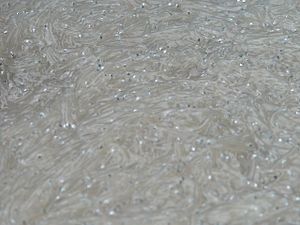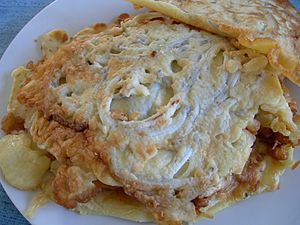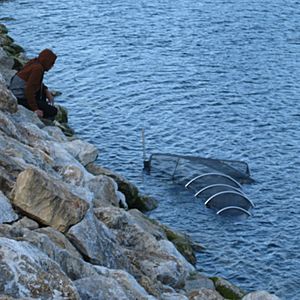Whitebait facts for kids
Whitebait is a name for very young fish, usually about 1 to 2 inches (25 to 50 mm) long. These small fish often swim together in large groups called schools near the coast. They can also move into estuaries (where rivers meet the sea) and sometimes even swim up rivers. This makes them easy to catch with special fine-meshed fishing nets. The activity of catching whitebait is called whitebaiting.
Whitebait are soft and can be eaten whole, including their heads, fins, bones, and insides. Many people think they are a special treat. Different types of fish are called "whitebait" in various parts of the world.
Because whitebait are the young of many important fish species (like herring, sprat, sardines, and mackerel), catching too many can harm future fish populations. For this reason, some countries have strict rules about how and when they can be caught.
Contents
Whitebait Around the World
Whitebait are enjoyed in many places, but the types of fish and how they are prepared can be very different.
Whitebait in Spain
People living along the northern coasts of the Alboran Sea in Spain have traditionally eaten whitebait. Even though selling these tiny fish has been banned, they remain a popular food.
Whitebait in Australia
In Australia, whitebait are the young of several types of galaxias fish. These fish return to freshwater rivers from the ocean as they grow.
Some species called whitebait in Australia include the Common galaxias, Climbing galaxias, and Spotted galaxias. In the past, many whitebait were caught for sale. Today, only people fishing for fun can catch them. They must follow strict rules and can only fish during a short season.
Whitebait in China
Chinese whitebait are often raised on fish farms. This means there are plenty of them for people to buy and for export. Chinese whitebait are usually bigger than those found in New Zealand and are not as delicate. You can often find them frozen in food stores and supermarkets. In China, they are often called "silver fish."
Whitebait in Italy
In Italy, whitebait are known as gianchetti or bianchetti. These are the young of Mediterranean fish like sardines and anchovies. They are caught with special nets in the early months of the year.
A popular dish in the Liguria region is gianchetti that are lightly boiled in salted water. They are served hot with oil and lemon juice. Another common way to eat them is in fritters, mixed with egg and flour and then deep-fried. Sometimes, they are simply dipped in flour and deep-fried. Red-colored gianchetti, called ruscetti, are tougher and are often used to flavor fish sauces.
In Sicilian cooking, whitebait are called ceruses, which means "baby." A special Sicilian dish is polpette di neonata, which are meatballs made from whitebait, parsley, and egg or flour. These are then fried in olive oil. In Naples, whitebait are known as cicenielli, and in Brindisi, they are called chuma, meaning "sea foam."
Whitebait in Japan
In Japan, the fishing of shirasu (whitebait) is very important in Shizuoka Prefecture. The shirasu are boiled in salted hot water and called kamaage shirasu.
Whitebait that are boiled and then partly dried are called shirasuboshi. If they are soft-dried, they are called Kantō boshi. If they are dried to be harder, they are called chirimen-jako or Kansai boshi.
The whitebait used for shirasu products are usually the young of the Japanese anchovy. Sometimes, a small number of young Japanese pilchards are also caught. A special treat is tatami iwashi, which is a very thin, square wafer made from uncooked, dried shirasu. It's like a paper-thin sheet of fish!
Whitebait in New Zealand
New Zealand whitebait are the young of five types of galaxias fish. These fish live as adults in freshwater rivers and streams. Four of these five species are considered endangered by the Department of Conservation. The whitebait are caught as they swim from the sea back into freshwater. They are much smaller than Chinese or British whitebait, usually about 45–55 mm long and around 15–22 weeks old.
The most common whitebait in New Zealand is the common galaxias. This fish lays its eggs in autumn during very high spring tides. The eggs are laid among grasses on the riverbanks that get flooded by the tide. The eggs develop out of the water until the next spring tide washes over them, which makes them hatch. The tiny fish then float out to sea and live there for about six months. After that, they swim back into freshwater to grow into adult fish.
New Zealand whitebait are caught in the lower parts of rivers using large, open nets. People fishing for whitebait must stay with their nets. They lift the net as soon as a group of whitebait swims in, because the fish can quickly swim back out. Some fishers use platforms called 'stands' with screens to guide the fish into their nets.
Whitebaiting in New Zealand is only allowed during a specific, limited time of year. This season is set to catch the common whitebait while protecting the rarer species that migrate at different times. There are strict rules about net sizes and how nets can be used. This helps make sure that some fish can still reach their adult homes. Whitebait are very good at avoiding nets.
Whitebait is a very special food in New Zealand and is quite expensive. It is usually sold fresh in small amounts, but some are frozen to sell later. You can usually only buy whitebait during or right after the fishing season. The most popular way to cook whitebait in New Zealand is the whitebait fritter. This is like an omelette with whitebait mixed in. Some people only use egg whites to keep the taste of the fish strong.
Sadly, whitebait catches have gone down because rivers and streams have been changed by farming and city growth. Losing places where whitebait can lay their eggs is a big problem. For example, if there isn't enough shade over the water, the developing whitebait eggs can die.
Whitebait in the United Kingdom
In the United Kingdom, whitebait usually means the young of Clupeidae fish, most often young sprats or herring. They are usually deep-fried after being coated in flour or a light batter. They are served very hot with lemon juice and bread and butter. It's hard to buy fresh whitebait unless you go to a fishing harbor early in the morning, as most are frozen on the boat.
People in England have been eating whitebait since at least 1612. By the 1780s, it was very popular to eat whitebait. In the past, people thought whitebait were their own special type of fish. In 1903, a study found that boxes sold as whitebait could contain up to 23 different types of young fish! These included young eels, plaice, whiting, herring, and bass, along with shrimp, crab, and even jellyfish.
In the 1800s, Londoners loved to take summer trips down the Thames to places like Greenwich to eat whitebait. Even the government's Cabinet would take such a trip every year. Today, an annual whitebait festival takes place in Southend.
Because whitebait in the UK are still young fish like herring and sprat, catching them can harm future fish numbers. Taking these fish when they are so young, before they can grow and have their own babies, can greatly reduce how many fish there will be later. The Marine Conservation Society (MCS) is a group that gives advice on how healthy fish populations are. They suggest avoiding eating and buying young whitebait to help keep fish numbers strong for the future.
Whitebait in Puerto Rico
People in Arecibo, Puerto Rico traditionally fish for whitebait at the mouth of the Río Grande de Arecibo. These fish are known locally as cetí.
Elvers
Elvers are young eels. Long ago, fishermen ate elvers because they were cheap. However, changes in the environment have caused eel populations to shrink. Now, like whitebait, elvers are considered a special food and can be very expensive.





